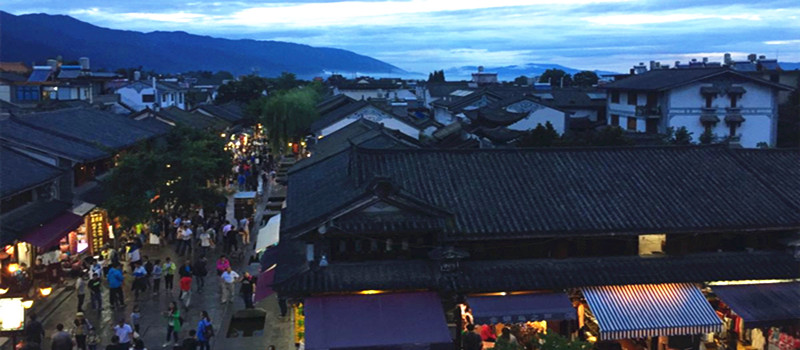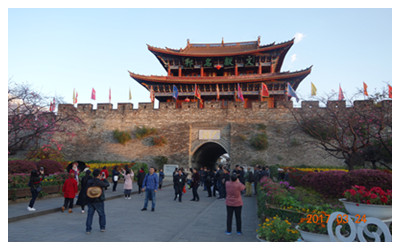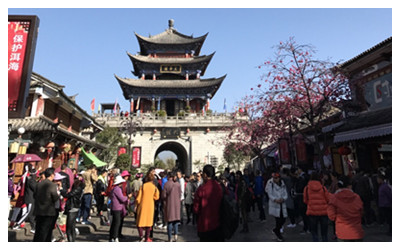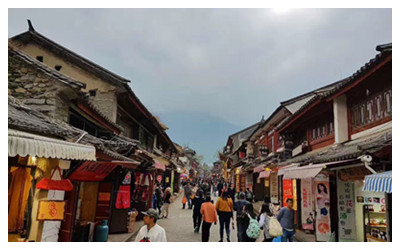Skype: neodalle-travel
Tel: +86 135 7447 2266
E-mail: sales@zhangjiajieholiday.com


What to see?
According to literature, Dali Ancient City was a gateway to the Silk Road in Southwest China, and also served as a seat of government and a major military barracks for Yunnan Province in ancient times. It enjoyed magnificent scale, with a wall length of 6 kilometers,a height of 7.5 meters and a thickness of 6 meters.
 Ancient City Gate Towers
Ancient City Gate Towers
There were four city gates facing west, east, north and south, upon which sat a gate tower. Four further towers were also placed at the four corners of the city wall. As it underwent many phases of prosperity as well as decline, only the city base remains till today. We can explore the mystery belonging to that period of history, especially through witnessing some parts of the city wall, the North City Wall Tower and the South City Wall Tower which were restored in 1982. The layout of Dali Ancient City was uniform, with five main streets from south to north and eight main streets from east to west, while marketplaces were neatly arranged within the city, which has remained unchanged to this date.
Bai Ethnic Traditional Houses
 The traditional Bai ethnic minority folk houses give the Dali Ancient City distinctive feel, unlike any other Chinese city. A typical house is characterized by '3 rooms and a wall screening' and '4 joints and 5 courtyards'. '3 rooms and a wall screening' means that every house has a principle room and two wing-rooms and facing the principle room stands the wall screening. When the sun shines on the wall screening in the afternoon, the sunlight is reflected back to the courtyard, thus illuminating the whole area. '4 joints and 5 courtyards' means houses are built with four sides; and four courtyards in the joining parts of the houses' corners and one big courtyard in the center makes five courtyards. The decoration is another construction feature of the folk residences, paying great attention to the gate tower, the eaves and corners. The windows, doors and the wall screening are adorned with Jianchuan woodcarvings, colored patterns, marbles and wash drawings. The delicacy, freshness and elegance of their construction may be called first-class among folk residences in Southwest China.
The traditional Bai ethnic minority folk houses give the Dali Ancient City distinctive feel, unlike any other Chinese city. A typical house is characterized by '3 rooms and a wall screening' and '4 joints and 5 courtyards'. '3 rooms and a wall screening' means that every house has a principle room and two wing-rooms and facing the principle room stands the wall screening. When the sun shines on the wall screening in the afternoon, the sunlight is reflected back to the courtyard, thus illuminating the whole area. '4 joints and 5 courtyards' means houses are built with four sides; and four courtyards in the joining parts of the houses' corners and one big courtyard in the center makes five courtyards. The decoration is another construction feature of the folk residences, paying great attention to the gate tower, the eaves and corners. The windows, doors and the wall screening are adorned with Jianchuan woodcarvings, colored patterns, marbles and wash drawings. The delicacy, freshness and elegance of their construction may be called first-class among folk residences in Southwest China.
Cobble-paved Streets
 When people walk along the cobble-paved streets in the Dali Ancient City, a sense of primitive simplicity and elegance will be invoked. Besides the Bai ethnic minority traditional folk houses, the houses all with grey-green roof tiles, peculiar workshops, temples, schools and churches with an antique flavor are scattered. Traditional artworks made of marble, such as pencil vases, striped screens, and a variety of woven handicrafts made of fine straw are laid chockablock on both sides of the street to be appreciated and purchased. The newly–opened Foreigner Street is also a must-see, providing snacks with the traditional flavors of the Bai ethnic community, as well as the famous 'Three-course Tea' ceremony for receiving guests that includes 'bitter tea', 'sweet tea' and 'final tea'.
When people walk along the cobble-paved streets in the Dali Ancient City, a sense of primitive simplicity and elegance will be invoked. Besides the Bai ethnic minority traditional folk houses, the houses all with grey-green roof tiles, peculiar workshops, temples, schools and churches with an antique flavor are scattered. Traditional artworks made of marble, such as pencil vases, striped screens, and a variety of woven handicrafts made of fine straw are laid chockablock on both sides of the street to be appreciated and purchased. The newly–opened Foreigner Street is also a must-see, providing snacks with the traditional flavors of the Bai ethnic community, as well as the famous 'Three-course Tea' ceremony for receiving guests that includes 'bitter tea', 'sweet tea' and 'final tea'.
Travel Tips
Add: Xiaguan District,Dali City, Yunnan Province
Entrance Fee: CNY 110
Opening Hours: 08:00-18:00
 Ask Questions ?
Ask Questions ?